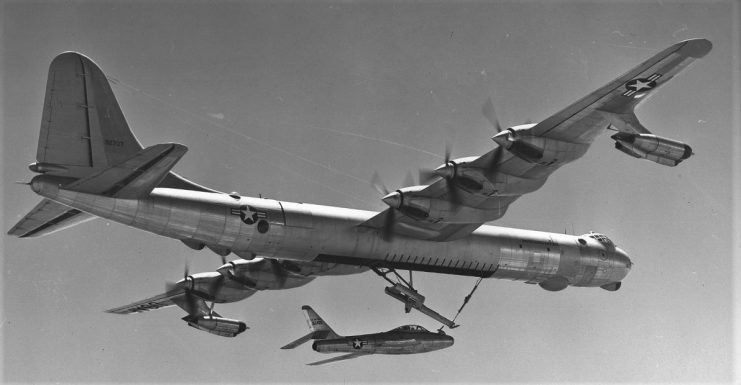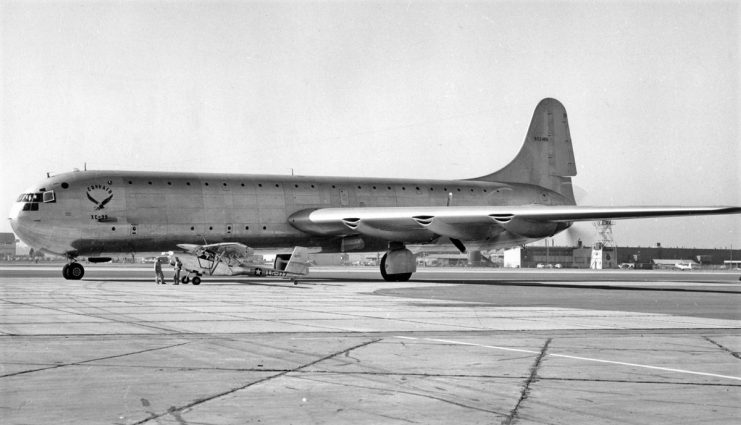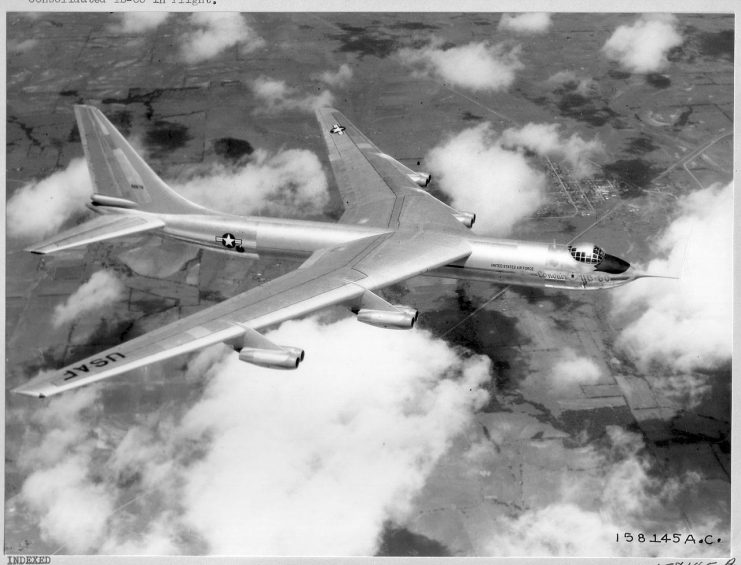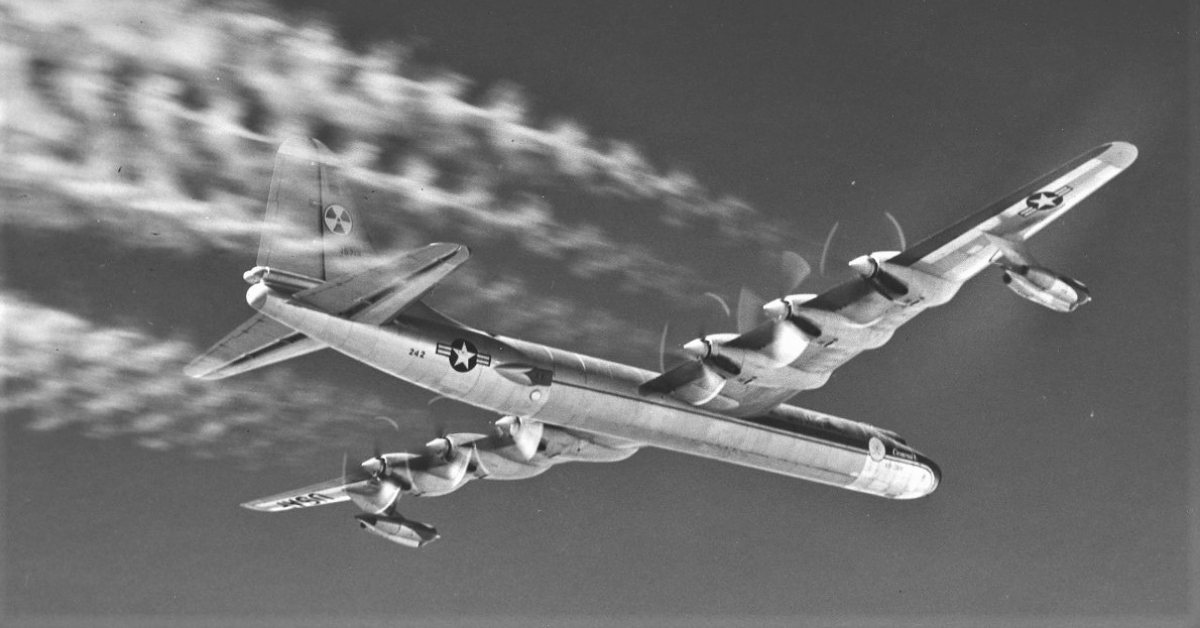The B-36 Peacemaker is the largest mass-produced piston-engine aircraft ever built with the longest wingspan of any combat aircraft ever built, at 230 ft (70.1 m).
The B-36 Peacemaker was the first bomber capable of delivering nuclear weapons to all continents. With a range of 10,000 mi (16,000 km) and a maximum payload of 87,200 lb (39,600 kg), the B-36 was capable of reaching out to Moscow.
It entered service in 1948, stayed operational until 1959, and was succeeded by the Jet-powered B-52 since 1955.
It was powered by 6 P&W R-4360 Wasp Major Radials, the largest and most capricious piston aero-engine, making it the final commercial radial engine before the Jet engine made its entry in the airliner market.
In later versions, the B-36-D, 4 Jet engines were added in pods slung under the outer wings. Depicted is NB-36H with the nuclear reactor experimentally installed.
A view of the later Convair GRB-36F, In 1951, this B-36F-1-CF Peacemaker was modified to “FICON” configuration (FICON standing for “Fighter Conveyor”). In that aircraft carrier role, it could carry a fighter into the air, launch, and recover her back in the belly via that special hook (the converted bomb bay).
The fighter in this image is a YRF-84F, about to be recovered to the mothership. The program lasted until 1953 when the USAF decided it wasn’t as practical as hoped for.
After serving as the FICON prototype carrier, this B-36 was further modified to the “Tom-Tom” carrier configuration where two F-84s were to be pulled on each wingtip of the B-36. Also, the Tom-Tom proved impractical, the idea was abandoned (info from Larry Westin, with special thanks).

XC-99 Cargo version of the B-36. In line with what Boeing did with its B-29 Superfortress, converting it into a cargo/pax/ tanker transport C-97/B-377 Stratocruiser, Convair tried to do the same with the B-36 platform.
The resulting XC-99 can be seen here. The design capacity of the XC-99 was 100,000 lb (45,000 kg) of cargo or 400 fully equipped soldiers on its double cargo decks.
The Convair Model 37 was a large civil passenger design derived from the XC-99 but was never built. The Model 37 was to be of similar proportions to the XC-99; 182 ft 6 in (55.63 m) length, 230 ft (70 m) wingspan, and a high-capacity, double-deck fuselage.
The projected passenger load was to be 204, and the effective range of 4,200 mi (6,800 km).
Fifteen aircraft of Model 37 were ordered by Pan American Airways for transatlantic service.
However, the fuel and oil consumption of the six 3,500 hp (2,600 kW) R-4360 Wasp Major radials powering the XC-99 and B-36 Peacemaker meant that the design was not economically viable, and the hoped-for turboprop powerplants did not materialize fast enough.
The low number of orders was not sufficient to initiate production, and the project was abandoned.

YB-60 Jet Peacemaker, the remake of the B-36 Peacemaker with Jet engines and swept wings and tail.
Two YB-60’s were built, this airplane, USAF serial number 49-2676, was the only airplane flown.
On 25 August 1950, Convair issued a proposal for a swept-winged version of the B-36 with all-jet propulsion. The United States Air Force was sufficiently interested that on 15 March 1951, it authorized Convair to convert two B-36Fs as B-36Gs. Since the aircraft was so radically different from the existing B-36, the designation was soon changed to YB-60.
The YB-60 had 72% parts commonality with its piston-engined predecessor. The fuselages of the two aircraft were largely identical, its tail surfaces were swept to match the wings.
The YB-60’s unofficial competitor for a contract was Boeing’s B-52 Stratofortress. Convair’s proposal was substantially cheaper than Boeing’s since it involved modifying an existing design rather than starting from scratch.
Like the B-52, it was powered by eight Pratt & Whitney J57-P-3 turbojets mounted in pairs in four pods suspended below the wing (giving both types a striking resemblance, except for that dome-shaped cockpit))
The maiden flight was on 18 April 1952. The Boeing YB-52 beat the Convair aircraft into the air by three days. The YB-60 was approximately 100 mph (160 km/h) slower than the YB-52 and also had severe handling problems.
It carried a heavier bomb load — 72,000 lb (33,000 kg) against 43,000 lb (20,000 kg) for the YB-52 — but the Air Force did not see the need for the extra capacity, given the YB-60’s other drawbacks.
Now Only One Left: Battle of Britain Pilot Passes Away on Eve of VE Day
The flight test programs were canceled on 20 January 1953. Since Convair completed its prototype contract, both YB-60s were formally accepted by the Air Force in 1954. The only operational aircraft never flew again, and both airframes were scrapped. (source Wikipedia)

Enjoy,
Hans Wiesman
www.dc3dakotahunter.com
www.catalinabook.com
If you like such fascinating photos and stories about Vintage Aviation/ Military History, come to see my websites for more information. Read about my blogs and books:
